 Get to Goa, and forget Kingfisher. Really. Try Arlem. A nice, Goan beer, with a nice bite, good taste and the ability to survive on the table. It tastes decent even after it warms up a bit. Find King's beer. Another great (sadly) local beer. Distinctive bottle and taste. And did I mention it's dirt cheap? Okay, who said Fosters?
Get to Goa, and forget Kingfisher. Really. Try Arlem. A nice, Goan beer, with a nice bite, good taste and the ability to survive on the table. It tastes decent even after it warms up a bit. Find King's beer. Another great (sadly) local beer. Distinctive bottle and taste. And did I mention it's dirt cheap? Okay, who said Fosters?
An evolving story of daily two-wheeled adventure in India... or something like that
Jul 28, 2006
Goa: Beer goggles
 Get to Goa, and forget Kingfisher. Really. Try Arlem. A nice, Goan beer, with a nice bite, good taste and the ability to survive on the table. It tastes decent even after it warms up a bit. Find King's beer. Another great (sadly) local beer. Distinctive bottle and taste. And did I mention it's dirt cheap? Okay, who said Fosters?
Get to Goa, and forget Kingfisher. Really. Try Arlem. A nice, Goan beer, with a nice bite, good taste and the ability to survive on the table. It tastes decent even after it warms up a bit. Find King's beer. Another great (sadly) local beer. Distinctive bottle and taste. And did I mention it's dirt cheap? Okay, who said Fosters?
Goa: Bem Venite
 Okay, that's a really bad one. I admit it. But, Hotel Venite, in Panjim isn't. In fact, it served up some of the best Goan grub I've ever had. It's on 31 January Road and you have to have a meal there. Staff is friendly, ambience is laid back-great, food is tasty and reasonably tagged and you'll be happy to return to it for a second round of gastronomy. The Beef-Sausage fry combination is brilliant. Ask for King's beer. It's going out of fashion, I hear, but what a beer! Desert must be bebinka with ice cream.
Okay, that's a really bad one. I admit it. But, Hotel Venite, in Panjim isn't. In fact, it served up some of the best Goan grub I've ever had. It's on 31 January Road and you have to have a meal there. Staff is friendly, ambience is laid back-great, food is tasty and reasonably tagged and you'll be happy to return to it for a second round of gastronomy. The Beef-Sausage fry combination is brilliant. Ask for King's beer. It's going out of fashion, I hear, but what a beer! Desert must be bebinka with ice cream.
Goa: Mum's the word
Goa: Martins cower
Goa: Off-season food hunt
Jul 17, 2006
Hero Honda Glamour FI: Riding Impression
Caught red handed
Jul 7, 2006
Bajaj Pulsar DTS-Fi: More images and specs

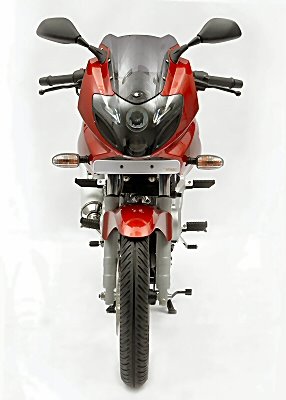
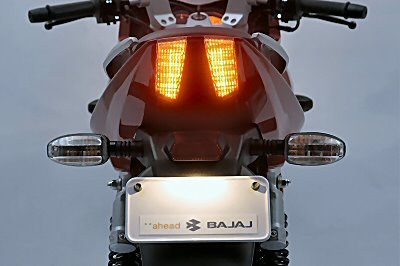
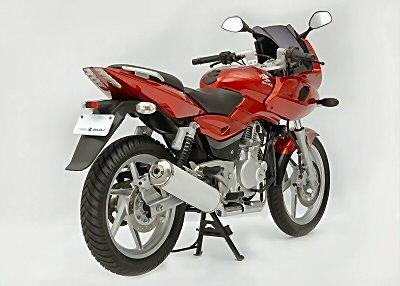

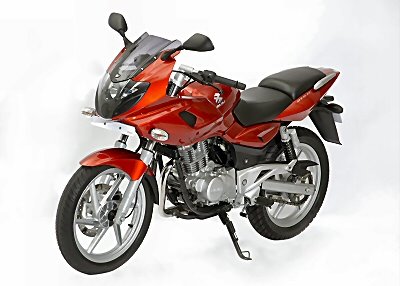
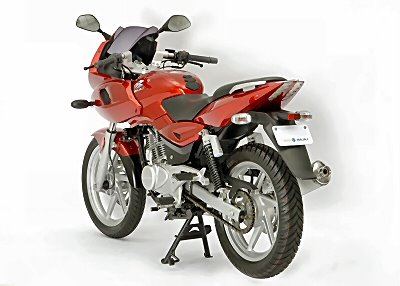
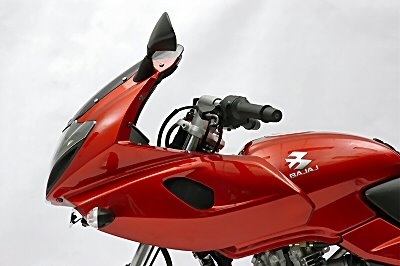

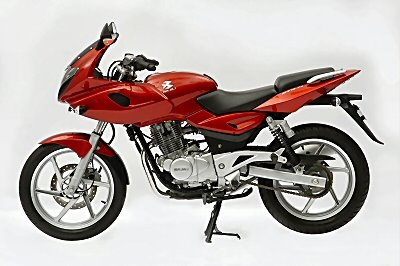
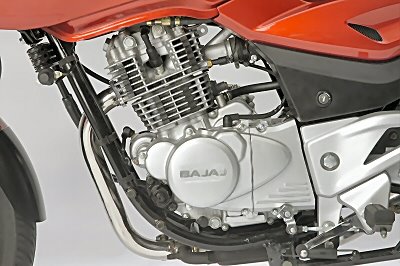 Engine
EngineType
Single Cylinder Air Cooled, 4 Stroke Sohc
Valve Train
2 Valve
Displacement
220cc
Bore & Stroke
NA
Comp. Ratio
NA
Starting
Electric Start only
Ignition/fuelling
Fuel injection (DTS-Fi)
- First four stroke engine in the world employing DTS-Fi technology
- Intelligently controlled ignition timing for each plug
- High combustion efficiency
- Low performance variability between engines
- Precise metering of fuel for highest outputs and lower emissions
- Easy engine starts in all conditions of temperature and altitude
- Best in class fuel economy [as in beating the Karizma? Is that even a task?
 First natural air-cooled 4-stroke engine in India employing a oil cooler
First natural air-cooled 4-stroke engine in India employing a oil cooler- Maintains lube-oil viscosity even under extreme conditions of stress and ambient temperatures.
- Also helps in cooling the engine internals
- First high capacity engine in India to employ rollers at rocker arm pivits and camshaft interfaces for low friction
- First engine in India to have electric start as the sole means of cranking
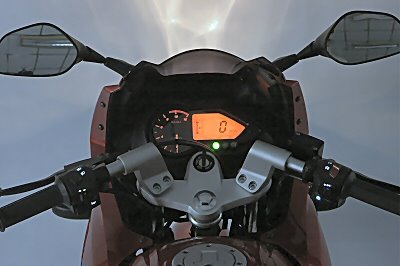 Performance
PerformanceMax. Power
20 bhp (no rpm claim)
Max. Torque
1.95 kgm (no rpm claim)
Top speed
135 kph
Fuel economy
50 kpl in 'sane riding'
Transmission
Gear Box
5 Speed Constant Mesh
Clutch
New. Superior to Pulsar 180/150
Electricals
Battery
MF typre, 12V 9Ah
Head Light
Ellipsoidal projector 55W/parabolic 55W H7
Tail Light
High intensity LEDs
Chassis
Type
Double cradle (new frame)
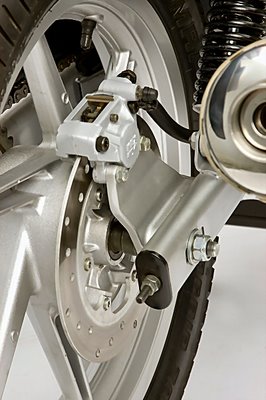 Suspension
SuspensionFront
37 mm Telescopic Hydraulic Type 130 mm travel
Rear
Ellipitical section Swing Arm With twin Hydraulic
Gas-charged Shock Absorbers; 101 mm travel
Brakes
Front
260mm Disc Type
Rear
230mm Disc Type
Tyres
Front
90/90-17 tubeless
Rear
120/80-17 tubeless
- First two wheeler in India to employ tubeless tyres for superior performance and safety
- First vehicle in the class to employ the widest tyres
- First vehicle in India to employ a hydraulically actuated 230 mm rear disc brake
- Enhances braking performance and control
- Enhances braking performance and control
- First bike in India to employ a large 37 mm front fork for class leading vehicle dynamics
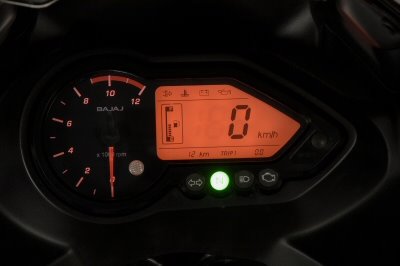 First...India to employ a non-contact digital speedo drive for accuracy, simplicity and long life
First...India to employ a non-contact digital speedo drive for accuracy, simplicity and long life- First...India to use clip-on handlebars
- First...India to use a unique damping method for damping high frequency vibrations in clip-on handlebars (patent applied for)
- First...India to employ a pure sports riding position [don't agree. Thought the bars could have been still lower and more sporty. Great position for fast touring, though]
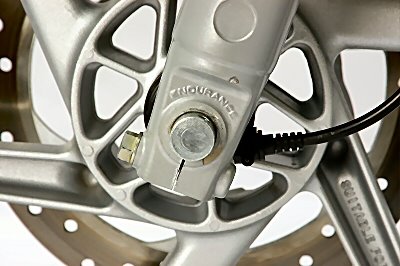 First...India to incorporate a pinch clamp for front axle
First...India to incorporate a pinch clamp for front axle- Ensures smooth parallel fork sliding action for lower fork stiction
- The usual method can force the legs to flex the tubes due to non-parallelism - high stiction
- First...India to use a 3000 combination ignition cum steering lock with a twin-track pilfer proof key
- First...world to employ backlit handlebar switches
- First...India to employ non-contact handlebar switches for soft touch feel and zero maintenance
- First...world to employ non-contact 'intelligent' self-cancelling turn signals
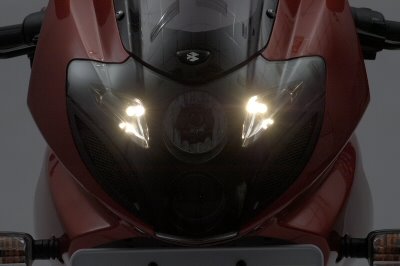 First...India to employ 'black mask' twin headlamps in a vertical stack configuration
First...India to employ 'black mask' twin headlamps in a vertical stack configuration- First...India to employ a high wattage (H7, 55W) ellipsoidal projector lamp for white light low beam illumination
- First...India to employ a high wattage (H7, 55W) compact clear lens parabolic lamp for white light high beam illumination
- First...India to employ white light pilot lamp bulbs
- First...India to employ a large free form orange backlit LCD speedo panel, displaying among other things the vehicle speed [accurate to within 2 kph], odometer, 2 tripmeters, graphic fuel level indicator and other information icons [diagnostics: air filter choked, oil temperature, battery voltage and oil level]
- First...India to employ a stepper motor driven tachometer needle for quick undamped response
- First...India to incorporate a flashing over-rev warning light in the speedo console
- First...India to have an electronic speedo console which when keyed on goes through a self-diagnostic check
- First...India which incorporates a flashing warning light for low fuel level
- First...India to incorporate a day-night mode for the speedo console. In day mode, the indicating lights are brighter for clear visibility in ambient sunlight. In night mode, these lights reduce their brightness to prevent glare
- First...India to employ a battery-saving function to automatically switch off headlamps while cranking
- First...India to employ a battery-saving function to automaticallyregulates the number of continuous cranks
- First...India equipped with a high-capacity O ring chain for final drive - smooth operation and long life in harsh operating conditions
- First...India employing elliptical section swingarm on needle roller pivot bearings
- First...India to incorporate sculpted, compact, fairing mounted rear view mirrors
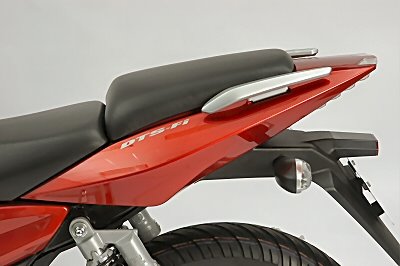 First...India with sporty, sculpted two-piece grab rail for sleek big bike looks
First...India with sporty, sculpted two-piece grab rail for sleek big bike looks- First...India with a split seat design for easy access to tool kit and first-aid kit
- First...India to sport 'twin slash' high intensity LED clear lens tail lamp, requiring zero maintenance
- First...India to sport and aggressive and stylish anti-scratch tank pad to prevent damage to petrol tank paintwork due to zippers
 Dimensions
DimensionsKerb Weight
150 kg
Wheel Base
1,350 mm
Length
2,035 mm
Width
750 mm
Overall Height
1,140 mm
Ground Clearance
177 mm
Tank Capacity
15 l
- Forced lubrication for the transmission
- Beefed up tranmission to handle high power and torque output
- Engine equipped with counterbalancer for controlling vibration from large dia piston
- Engine equipped with oil level inspection window
- Improved fin geometry for better heat dissipation
- DTS-Fi system is optimised for razor sharp response to throttle inputs
 New high strength chassis designed to handle high engine outputs and making possible precise handling traits with arrow-like straightline stability
New high strength chassis designed to handle high engine outputs and making possible precise handling traits with arrow-like straightline stability- Large 260 mm front disc for precise and progressive braking
- Crystal finished clear lens blinkers to complement the clear lens tail lamp
- DC Ignition and lighting ensures quicker engine startups and constant illumination
- Low maintenance battery to reduce frequent top-up needs
- A red malfunction indicator lamp in the speedo gives the error codes in order to identify any malfunctioning fuel injection components
- Sculpted looking top clamp with pinch bolts for greater rigidity
- New gear shifting mechanism for a positive shift feel [really works ]
- New low friction shift drum for a smoother shift feel [really works ]
- New large capacity clutch incorporating anti-judder mechanism for superior clutch performance in all conditions
- Highest power to weight ratio: 133 PS/Tonne
- High flow intake and exhaust ports
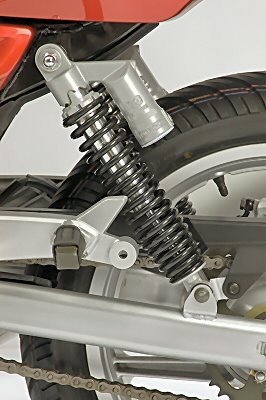 Large bore, light slipper type piston
Large bore, light slipper type piston- Large capacity main bearings for high output handling
- Large capacity output shaft bearing to handle high loads
- Equipped with a roll-over sensor to cut off fuel supply in case of a vehicle fall
- Brake and shift lever pivots incorporated on the footpeg mounting to give a clean, uncluttered look
- Nitrox rear shocks optimised (spring and damper ratings) for all riding conditions
- High output 200 watt, 3-phase magneto
- All stainless steel exhaust with a sporty aluminium clad canister
- ExhuasTEC
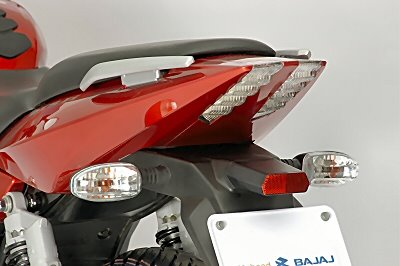 Earlier post about the Bajaj Pulsar DTS-Fi: Here
Earlier post about the Bajaj Pulsar DTS-Fi: HereCATEGORY: MOTORCYCLES

Jul 5, 2006
Corporate Con: Bajaj Pulsar 180 DTSi; The Reply
Had a chat with a senior marketing person from Bajaj. Roundly criticised the Fear The Black advertisement. And in reply, I ended up with a most interesting perspective on how advertisements work.
I was told, ‘I really don’t care how aesthetically great, or otherwise, you thought the advertisement was. You object to the street bike jumping, crossing dams and all of that. Other people have told me the star of the ad was the pair of sunglasses. Still others have called it a failure…’
‘But, we didn’t make the ad to please aesthetes. We made the advertisement to get people to come to our showrooms. That has happened. From the 180 sales of roughly 1500 a month, right after the advert first aired, sales have been growing. We’re at almost 6000 units a month and growing. To me, that was not only a successful advertisement, it was one of the more successful ads we have made.’
Book review: The Kite Runner
Book review: On Mexican Time
 Tom Cohan’s On Mexican Time was a impulse purchase on the wife’s part at Stand’s annual sale. It’s a sort of pilgrimage for us… The book is about a successful arty couple from LA, who slowly let go of big city life for a slower, more relaxed style of life. Yes, in
Tom Cohan’s On Mexican Time was a impulse purchase on the wife’s part at Stand’s annual sale. It’s a sort of pilgrimage for us… The book is about a successful arty couple from LA, who slowly let go of big city life for a slower, more relaxed style of life. Yes, in CATEGORY: THE ARTS
How to use clutch and gears
The clutch is a mechanism that allows the engine to run without affecting the rear wheel. In effect, it is used to isolate the engine and the rear wheel. The beauty of it is that it allows an infinite amount of adjustment of how isolated they are. And that adjustment is made by you, the rider. Without becoming too technical, here'’s the basic process. When you pull the clutch lever in, you disconnect the engine from the rear wheel. Try it on your bike. If it does not disconnect, you need to get your clutch adjusted. Now, with your bike on a main stand (resting on the front wheel and the stand, rear wheel off the ground), try releasing the clutch lever slowly. You should feel a point where the lever becomes '‘harder.'’ At this point, the rear wheel should start turning slowly. We call this the friction point. This is where the smallest link between the engine and the rear wheel is formed. From the friction point onwards, the further you let the clutch lever out, the stronger the link should become. When the lever is out, if your clutch is adjusted properly, the link should be complete.
We use the clutch to smoothen shifting gears. We use it to roll off from a standing start in first gear. We use it stop the engine from stalling (shutting off) just before we stop. And sometimes, in very slow traffic, we use it as a sort of soft brake to keep the bike rolling at very slow speed without the jerks that come from rolling on and off the throttle in first gear. Remember, apart from the last use, each clutch use is a finite event. It begins and ends and you should never find yourself with a half-depressed clutch lever except in the last situation.
The gears '‘convert'’ the engine'’s power into a more useable form. For instance, your engine speed (see your tacho) is 2500 rpm. If directly connected to your rear wheel, it would make the wheel turn that fast. At 2500 rpm, your average motorcycle will be travelling nearly 2 km on its 18-inch wheels every second. Which, as you can tell, would be scary and uncontrollable. The gearbox turns the 2500 rpm engine speed to a more reasonable and controllable speed of rotation for the rear wheel of a motorcycle. Again, without taking on the mechanical complexity of gearboxes, here'’s how to use them.
Your motorcycle will usually have four to five gears. First if primarily to get rolling. You shift into first (down on most motorcycles, up on Hero Hondas and some TVSs) with the clutch in. then, holding the throttle steady, you let the clutch out to get the bike rolling. At about fifteen-twenty kph, shift up into second (up on most bikes, up on Hero Hondas and TVSs, down on some Bajajs). If you have a tachometer, the idea is to keep the revs in the green band (that'’s good enough for beginners). If it drops below the green, shift down to a lower gear. If rises above the green, shift up to a higher gear. Basically, select a gear in the same direction as the needle is. Lower for below green and higher for above green.
Once you get more experienced, you can use the tachometer and the gears to control how much power you motorcycle is making. As you ride outside the green band, for instance, you will find a sweet spot, where the motorcycle seems most comfortable, most powerful. All you have to do now, is to keep the bike in that zone, again, using the same rule as in the previous paragraph.
When you are shifting down, advanced rides do something called matching revs (see this post), but donÂ’t worry about that for now. Once you get comfortable with using the gears, you can worry about finesse.
When slowing down, you will want to bring the bike down the gears as well. Usually, motorcycle transmissions hate to be shifted click-click-click down from fourth to first. So give them a break. Let the clutch in to just past friction point between shifts to ease the pressure on the system. That, more or less, is the gist of it. The rest is the art of clutchwork and gearwork. More on that later...
Jul 1, 2006
Pulsar 220 DTS-Fi official image

Okay, here's some more info
220cc. 20 bhp. 135 kph. 50 kpl (sane riding)
five figure price tag. Diwali-ish (guess).
MOR INFORMATION ON THE BIKE IS HERE






